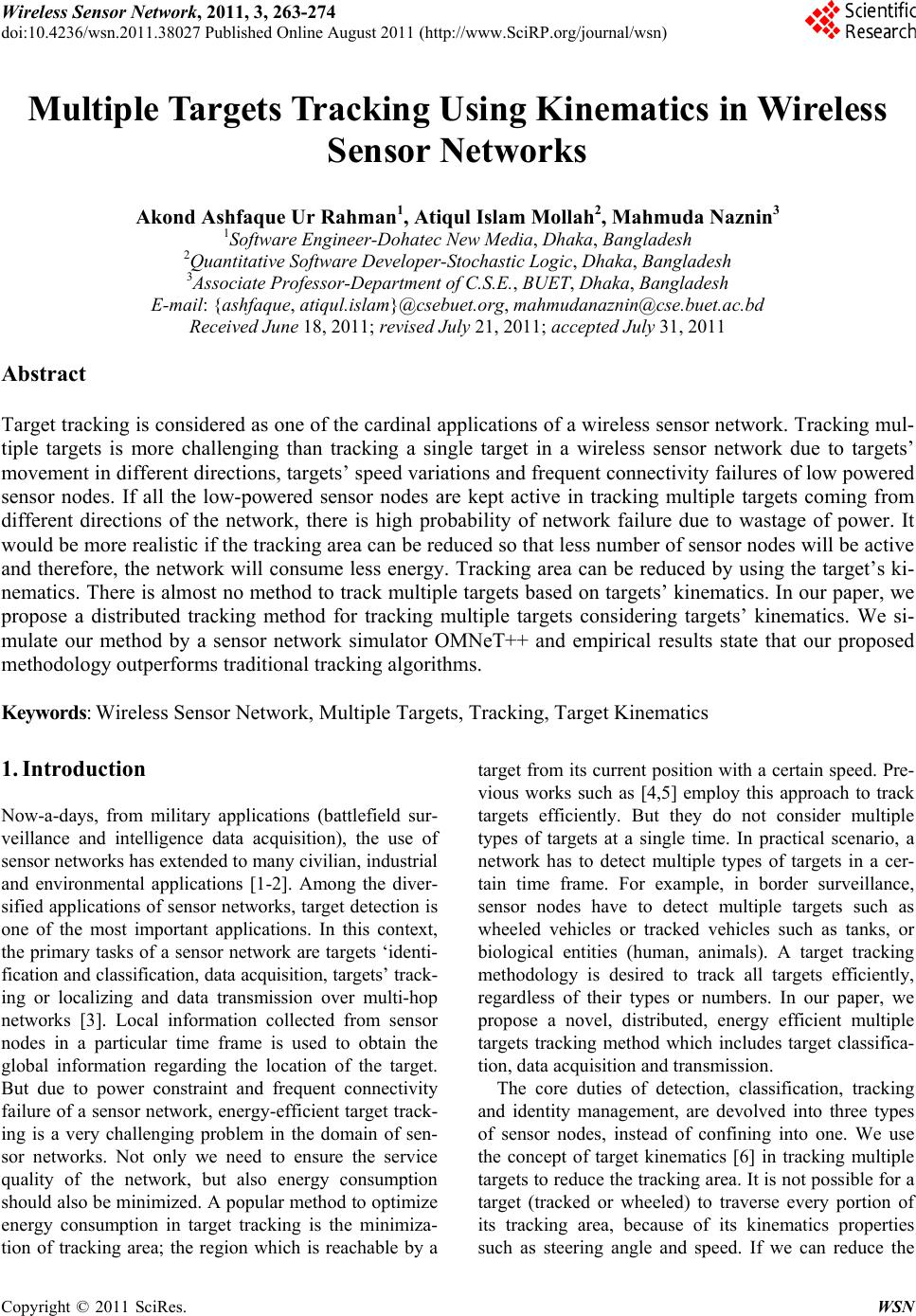 Wireless Sensor Network, 2011, 3, 263-274 doi:10.4236/wsn.2011.38027 Published Online August 2011 (http://www.SciRP.org/journal/wsn) Copyright © 2011 SciRes. WSN Multiple Targets Tracking Using Kinematics in Wireless Sensor Networks Akond Ashfaque Ur Rahman1, Atiqul Islam Mollah2, Mahmuda Naznin3 1Software Engineer-Dohatec New Media, Dhaka, Bangladesh 2Quantitative Software Developer-Stochastic Logic, Dhaka, Bangladesh 3Associate Professor-Department of C.S.E., BUET, Dhaka, Bangladesh E-mail: {ashfaque, atiqul.islam}@csebuet.org, mahmudanaznin@cse.buet.ac.bd Received June 18, 2011; revised July 21, 2011; accepted July 31, 2011 Abstract Target tracking is considered as one of the cardinal applications of a wireless sensor network. Tracking mul- tiple targets is more challenging than tracking a single target in a wireless sensor network due to targets’ movement in different directions, targets’ speed variations and frequent connectivity failures of low powered sensor nodes. If all the low-powered sensor nodes are kept active in tracking multiple targets coming from different directions of the network, there is high probability of network failure due to wastage of power. It would be more realistic if the tracking area can be reduced so that less number of sensor nodes will be active and therefore, the network will consume less energy. Tracking area can be reduced by using the target’s ki- nematics. There is almost no method to track multiple targets based on targets’ kinematics. In our paper, we propose a distributed tracking method for tracking multiple targets considering targets’ kinematics. We si- mulate our method by a sensor network simulator OMNeT++ and empirical results state that our proposed methodology outperforms traditional tracking algorithms. Keywords: Wireless Sensor Network, Multiple Targets, Tracking, Target Kinematics 1. Introduction Now-a-days, from military applications (battlefield sur- veillance and intelligence data acquisition), the use of sensor networks has extended to many civilian, industrial and environmental applications [1-2]. Among the diver- sified applications of sensor networks, target detection is one of the most important applications. In this context, the primary tasks of a sensor network are targets ‘identi- fication and classification, data acquisition, targets’ track- ing or localizing and data transmission over multi-hop networks [3]. Local information collected from sensor nodes in a particular time frame is used to obtain the global information regarding the location of the target. But due to power constraint and frequent connectivity failure of a sensor network, energy-efficient target track- ing is a very challenging problem in the domain of sen- sor networks. Not only we need to ensure the service quality of the network, but also energy consumption should also be minimized. A popular method to optimize energy consumption in target tracking is the minimiza- tion of tracking area; the region which is reachable by a target from its current position with a certain speed. Pre- vious works such as [4,5] employ this approach to track targets efficiently. But they do not consider multiple types of targets at a single time. In practical scenario, a network has to detect multiple types of targets in a cer- tain time frame. For example, in border surveillance, sensor nodes have to detect multiple targets such as wheeled vehicles or tracked vehicles such as tanks, or biological entities (human, animals). A target tracking methodology is desired to track all targets efficiently, regardless of their types or numbers. In our paper, we propose a novel, distributed, energy efficient multiple targets tracking method which includes target classifica- tion, data acquisition and transmission. The core duties of detection, classification, tracking and identity management, are devolved into three types of sensor nodes, instead of confining into one. We use the concept of target kinematics [6] in tracking multiple targets to reduce the tracking area. It is not possible for a target (tracked or wheeled) to traverse every portion of its tracking area, because of its kinematics properties such as steering angle and speed. If we can reduce the 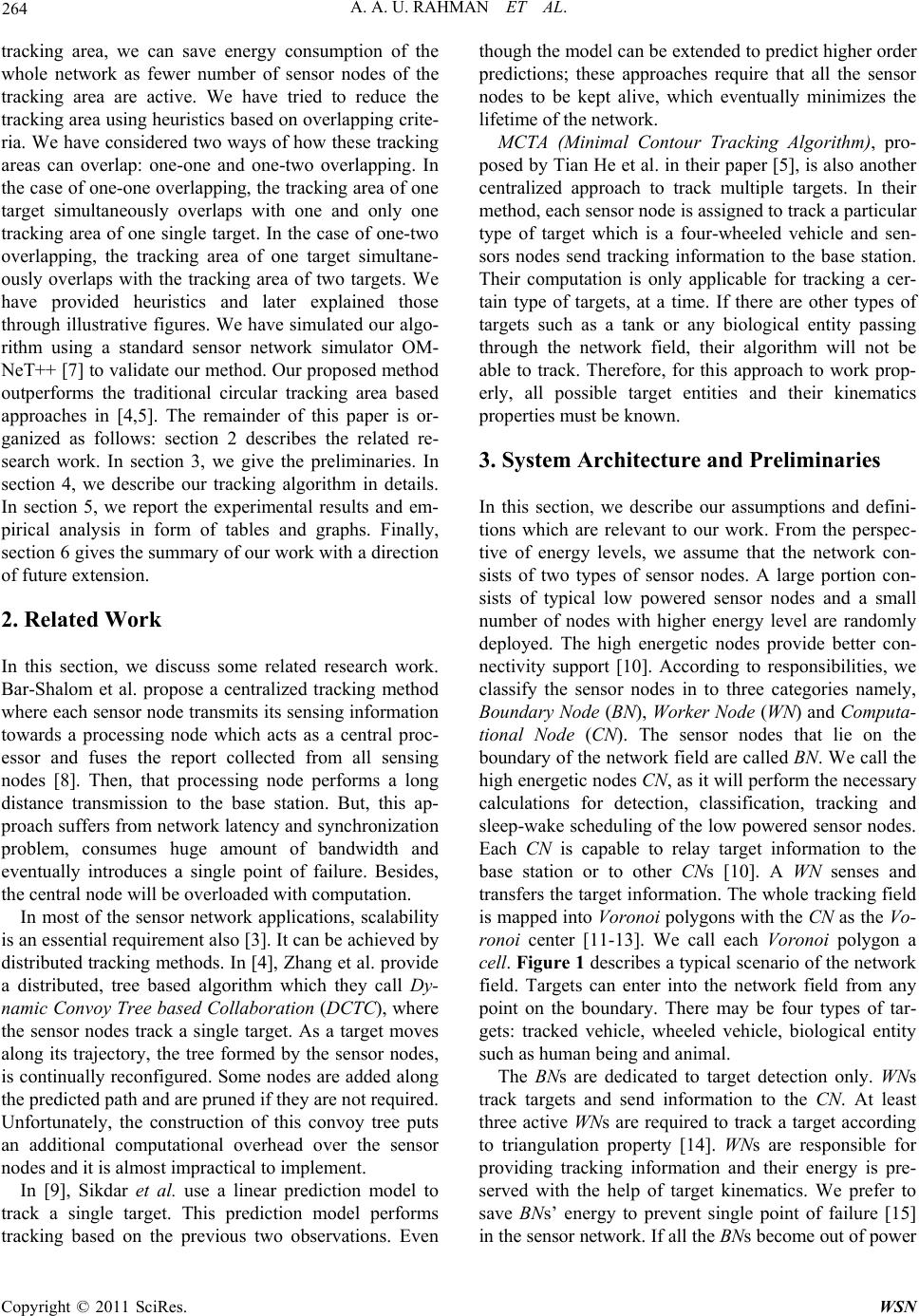 264 A. A. U. RAHMAN ET AL. tracking area, we can save energy consumption of the whole network as fewer number of sensor nodes of the tracking area are active. We have tried to reduce the tracking area using heuristics based on overlapping crite- ria. We have considered two ways of how these tracking areas can overlap: one-one and one-two overlapping. In the case of one-one overlapping, the tracking area of one target simultaneously overlaps with one and only one tracking area of one single target. In the case of one-two overlapping, the tracking area of one target simultane- ously overlaps with the tracking area of two targets. We have provided heuristics and later explained those through illustrative figures. We have simulated our algo- rithm using a standard sensor network simulator OM- NeT++ [7] to validate our method. Our proposed method outperforms the traditional circular tracking area based approaches in [4,5]. The remainder of this paper is or- ganized as follows: section 2 describes the related re- search work. In section 3, we give the preliminaries. In section 4, we describe our tracking algorithm in details. In section 5, we report the experimental results and em- pirical analysis in form of tables and graphs. Finally, section 6 gives the summary of our work with a direction of future extension. 2. Related Work In this section, we discuss some related research work. Bar-Shalom et al. propose a centralized tracking method where each sensor node transmits its sensing information towards a processing node which acts as a central proc- essor and fuses the report collected from all sensing nodes [8]. Then, that processing node performs a long distance transmission to the base station. But, this ap- proach suffers from network latency and synchronization problem, consumes huge amount of bandwidth and eventually introduces a single point of failure. Besides, the central node will be overloaded with computation. In most of the sensor network applications, scalability is an essential requirement also [3]. It can be achieved by distributed tracking methods. In [4], Zhang et al. provide a distributed, tree based algorithm which they call Dy- namic Convoy Tree based Collaboration (DCTC), where the sensor nodes track a single target. As a target moves along its trajectory, the tree formed by the sensor nodes, is continually reconfigured. Some nodes are added along the predicted path and are pruned if they are not required. Unfortunately, the construction of this convoy tree puts an additional computational overhead over the sensor nodes and it is almost impractical to implement. In [9], Sikdar et al. use a linear prediction model to track a single target. This prediction model performs tracking based on the previous two observations. Even though the model can be extended to predict higher order predictions; these approaches require that all the sensor nodes to be kept alive, which eventually minimizes the lifetime of the network. MCTA (Minimal Contour Tracking Algorithm), pro- posed by Tian He et al. in their paper [5], is also another centralized approach to track multiple targets. In their method, each sensor node is assigned to track a particular type of target which is a four-wheeled vehicle and sen- sors nodes send tracking information to the base station. Their computation is only applicable for tracking a cer- tain type of targets, at a time. If there are other types of targets such as a tank or any biological entity passing through the network field, their algorithm will not be able to track. Therefore, for this approach to work prop- erly, all possible target entities and their kinematics properties must be known. 3. System Architecture and Preliminaries In this section, we describe our assumptions and defini- tions which are relevant to our work. From the perspec- tive of energy levels, we assume that the network con- sists of two types of sensor nodes. A large portion con- sists of typical low powered sensor nodes and a small number of nodes with higher energy level are randomly deployed. The high energetic nodes provide better con- nectivity support [10]. According to responsibilities, we classify the sensor nodes in to three categories namely, Boundary Node (BN), Worker Node (WN) and Computa- tional Node (CN). The sensor nodes that lie on the boundary of the network field are called BN. We call the high energetic nodes CN, as it will perform the necessary calculations for detection, classification, tracking and sleep-wake scheduling of the low powered sensor nodes. Each CN is capable to relay target information to the base station or to other CNs [10]. A WN senses and transfers the target information. The whole tracking field is mapped into Voronoi polygons with the CN as the Vo- ronoi center [11-13]. We call each Voronoi polygon a cell. Figure 1 describes a typical scenario of the network field. Targets can enter into the network field from any point on the boundary. There may be four types of tar- gets: tracked vehicle, wheeled vehicle, biological entity such as human being and animal. The BNs are dedicated to target detection only. WNs track targets and send information to the CN. At least three active WNs are required to track a target according to triangulation property [14]. WNs are responsible for providing tracking information and their energy is pre- served with the help of target kinematics. We prefer to save BNs’ energy to prevent single point of failure [15] in the sensor network. If all the BNs become out of power Copyright © 2011 SciRes. WSN 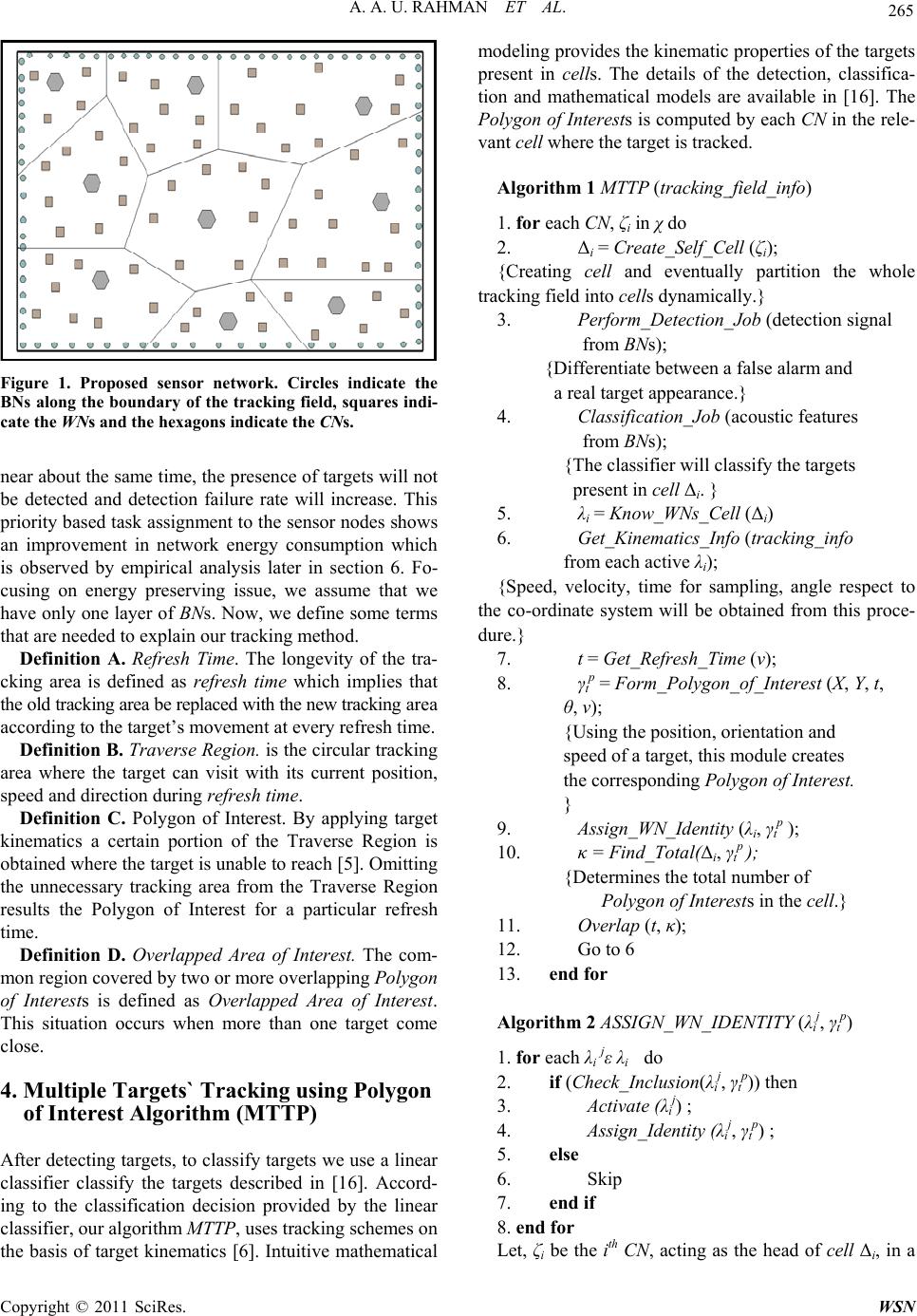 A. A. U. RAHMAN ET AL. 265 Figure 1. Proposed sensor network. Circles indicate the BNs along the boundary of the tracking field, squares indi- cate the WNs and the hexagons indicate the CNs. near about the same time, the presence of targets will not be detected and detection failure rate will increase. This priority based task assignment to the sensor nodes shows an improvement in network energy consumption which is observed by empirical analysis later in section 6. Fo- cusing on energy preserving issue, we assume that we have only one layer of BNs. Now, we define some terms that are needed to explain our tracking method. Definition A. Refresh Time. The longevity of the tra- cking area is defined as refresh time which implies that the old tracking area be replaced with the new tracking area according to the target’s movement at every refresh time. Definition B. Traverse Region. is the circular tracking area where the target can visit with its current position, speed and direction during refresh time. Definition C. Polygon of Interest. By applying target kinematics a certain portion of the Traverse Region is obtained where the target is unable to reach [5]. Omitting the unnecessary tracking area from the Traverse Region results the Polygon of Interest for a particular refresh time. Definition D. Overlapped Area of Interest. The com- mon region covered by two or more overlapping Polygon of Interests is defined as Overlapped Area of Interest. This situation occurs when more than one target come close. 4. Multiple Targets` Tracking using Polygon of Interest Algorithm (MTTP) After detecting targets, to classify targets we use a linear classifier classify the targets described in [16]. Accord- ing to the classification decision provided by the linear classifier, our algorithm MTTP, uses tracking schemes on the basis of target kinematics [6]. Intuitive mathematical modeling provides the kinematic properties of the targets present in cells. The details of the detection, classifica- tion and mathematical models are available in [16]. The Polygon of Interests is computed by each CN in the rele- vant cell where the target is tracked. Algorithm 1 MTTP (tracking_field_info) 1. for each CN, ζi in χ do 2. Δi = Create_Self_Cell (ζi); {Creating cell and eventually partition the whole tracking field into cells dynamically.} 3. Perform_Detection_Job (detection signal from BNs); {Differentiate between a false alarm and a real target appearance.} 4. Classification_Job (acoustic features from BNs); {The classifier will classify the targets present in cell Δi. } 5. λi = Know_WNs_Cell (Δi) 6. Get_Kin ematics_Info (tracking_info from each active λi); {Speed, velocity, time for sampling, angle respect to the co-ordinate system will be obtained from this proce- dure.} 7. t = Get_Refresh_Time (v); 8. γt p = Form_Polygon_of_In terest (X, Y, t, θ, v); {Using the position, orientation and speed of a target, this module creates the corresponding Polygon of Interest. } 9. Assign_ WN_Identity (λi, γt p ); 10. κ = Find_Total(Δi, γt p ); {Determines the total number of Polygon of Interests in the cell.} 11. Overlap (t, κ); 12. Go to 6 13. end for Algorithm 2 ASSIGN_WN_IDENTITY (λi j, γt p) 1. for each λi jε λi do 2. if (Check_Inclusion(λi j, γt p)) then 3. Activa te (λi j) ; 4. Assig n_Identity (λi j, γt p) ; 5. else 6. Skip 7. end if 8. end for Let, ζi be the ith CN, acting as the head of cell Δi, in a Copyright © 2011 SciRes. WSN 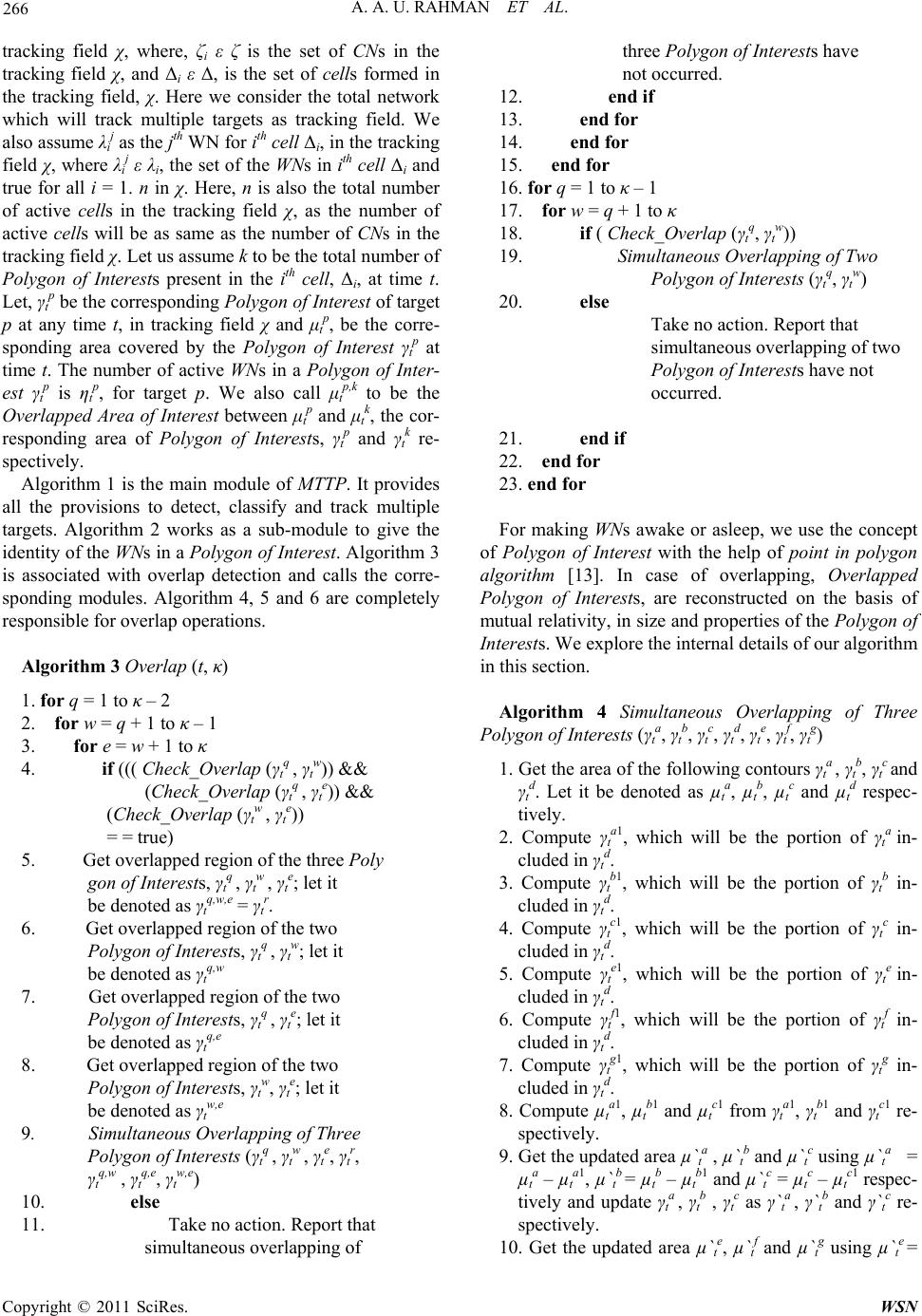 266 A. A. U. RAHMAN ET AL. tracking field χ, where, ζi ε ζ is the set of CNs in the tracking field χ, and Δi ε Δ, is the set of cells formed in the tracking field, χ. Here we consider the total network which will track multiple targets as tracking field. We also assume λi j as the jth WN for ith cell Δi, in the tracking field χ, where λi j ε λi, the set of the WNs in ith cell Δi and true for all i = 1. n in χ. Here, n is also the total number of active cells in the tracking field χ, as the number of active cells will be as same as the number of CNs in the tracking field χ. Let us assume k to be the total number of Polygon of Interests present in the ith cell, Δi, at time t. Let, γt p be the corresponding Polygon of Interest of target p at any time t, in tracking field χ and μt p, be the corre- sponding area covered by the Polygon of Interest γt p at time t. The number of active WNs in a Polygon of Inter- est γt p is ηt p, for target p. We also call μt p,k to be the Overlapped Area of Interest between μt p and μt k, the cor- responding area of Polygon of Interests, γt p and γt k re- spectively. Algorithm 1 is the main module of MTTP. It provides all the provisions to detect, classify and track multiple targets. Algorithm 2 works as a sub-module to give the identity of the WNs in a Polygon of Interest. Algorithm 3 is associated with overlap detection and calls the corre- sponding modules. Algorithm 4, 5 and 6 are completely responsible for overlap operations. Algorithm 3 Overlap (t, κ) 1. for q = 1 to κ – 2 2. for w = q + 1 to κ – 1 3. for e = w + 1 to κ 4. if ((( Check_Overlap (γt q , γt w)) && (Check_Overlap (γt q , γt e)) && (Check_Overlap (γt w , γt e)) = = true) 5. Get overlapped region of the three Poly gon of Interests, γt q , γt w , γt e; let it be denoted as γt q,w,e = γt r. 6. Get overlapped region of the two Polygon of Interests, γt q , γt w; let it be denoted as γt q,w 7. Get overlapped region of the two Polygon of Interests, γt q , γt e; let it be denoted as γt q,e 8. Get overlapped region of the two Polygon of Interests, γt w, γt e; let it be denoted as γt w,e 9. Simultaneous Overlapping of Three Polygon of Interests (γt q , γt w , γt e, γt r, γt q,w , γt q,e, γt w,e) 10. else 11. Take no action. Report that simultaneous overlapping of three Polygon of Interests have not occurred. 12. end if 13. end for 14. end for 15. end for 16. for q = 1 to κ – 1 17. for w = q + 1 to κ 18. if ( Check_Overlap (γt q, γt w)) 19. Simultaneous Overlapping of Two Polygon of Interests (γt q, γt w) 20. else Take no action. Report that simultaneous overlapping of two Polygon of Interests have not occurred. 21. end if 22. end for 23. end for For making WNs awake or asleep, we use the concept of Polygon of Interest with the help of point in polygon algorithm [13]. In case of overlapping, Overlapped Polygon of Interests, are reconstructed on the basis of mutual relativity, in size and properties of the Polygon of Interests. We explore the internal details of our algorithm in this section. Algorithm 4 Simultaneous Overlapping of Three Polygon of Interests (γt a, γt b, γt c, γt d, γt e, γt f, γt g) 1. Get the area of the following contours γt a , γt b, γt c and γt d. Let it be denoted as µt a, µt b, µt c and µt d respec- tively. 2. Compute γt a1, which will be the portion of γt a in- cluded in γt d. 3. Compute γt b1, which will be the portion of γt b in- cluded in γt d. 4. Compute γt c1, which will be the portion of γt c in- cluded in γt d. 5. Compute γt e1, which will be the portion of γt e in- cluded in γt d. 6. Compute γt f1, which will be the portion of γt f in- cluded in γt d. 7. Compute γt g1, which will be the portion of γt g in- cluded in γt d. 8. Compute µt a1, µt b1 and µt c1 from γt a1, γt b1 and γt c1 re- spectively. 9. Get the updated area µ`t a , µ`t b and µ`t c using µ`t a = µt a – µt a1, µ` t b = µt b – µt b1 and µ`t c = µt c – µt c1 respec- tively and update γt a , γt b , γt c as γ`t a , γ`t b and γ`t c re- spectively. 10. Get the updated area µ`t e, µ` t f and µ` t g using µ`t e = Copyright © 2011 SciRes. WSN  A. A. U. RAHMAN ET AL. 267 µt e – µt e1, µ` t f = µt f – µt f1 and µ`t g = µt g – µt g1 respec- tively and update γt e , γt f , γt g as γ`t e , γ`t f and γ`t g re- spectively. 11. Calculate ηt 1, ηt 2 and ηt 3 from γ`t a , γ`t b and γ`t c re- spectively. 12. If (ηt 1 => 3) 13. Individual Minimization (γ`t a, γ`t e, γ`t f) 14. Else 15. Preserve γt a. No minimization will take place. Return γt a 16. If (ηt 2 => 3) 17. Individual Minimization (γ`t b, γ`t e, γ`t g) 18. Else 19. Preserve γt b. No minimization will take place. Return γt b 20. If (ηt 3 => 3) 21. Individual Minimization (γ`t c, γ`t f, γ`t g) 22. Else 23. Preserve γt c. No minimization will take place. Return γt c For simplicity, to describe the overlapping issue we consider two Polygon of Interests of two targets at a cer- tain time t. We check overlapping, by relatively detecting the inclusion of one Polygon of Interest into another. The WNs remain completely static during tracking. The Polygon of Interests is reconstructed in such a way that each of the Polygon of Interest possesses the sufficient number of WNs to track the targets. Let two Polygon of Interests be, γt a and γt b where μt a and μt b, are respectively their areas. The number of WNs in γt a and γt b is respec- tively denoted as, ηt a and ηt b. We check the inclusion of γt b, which we call the Compared Polygon of Interest into the Comparing Polygon of Interest, γt a. If the inclusion is true we consider the two Polygon of Interests to be over- lapped. Then we calculate the area common between the Polygon of Interests, γt a, γt b and denote it as μt a,b. We then adjust μt b, which represents the area of Compared Poly- gon of Interest γt b, by subtracting μt a,b from it. ηt a, ηt b, ηt a,b is also adjusted accordingly. We illustrate three cases based on the value of ηt b . Algorithm 5 Individual Minimization (γt 1, γt 2, γt 3) 1. Compute γt x as the area of γt 1 which is included in the area of γt 2 2. Compute γt y as the area of γt 1 which is included in the area of γt 3 3. Compute µt x and µt y from γt x and γt y respectively 4. Calculate γt 1 as γt 0 using µt 0 = µt 1 – µt x 5. Calculate γt 1 as γt 9 using µt 9 = µt 1 – µt y 6. Calculate ηt 9 and ηt 0. 7. If (ηt 9 => 3 || ηt 0 => 3) 8. Calculate ηt Factor = Minimum (ηt 9, ηt 0) 9. If ηt Factor => 3 10. Compute γt Factor in correspondence to ηt Factor 11. Preserve γt Factor 12. Else 13. Calculate ηt Factor = Maximum (ηt 9, ηt 0) 14. Compute γt Factor in correspondence to ηt Factor 15. Preserve γt Factor 16. Return γt Factor 17. Else 18. Preserve γt 1 19. Return γt 1 In the following illustration we study how Overlapped Area of Interests effect the tracking decision policy while tracking multiple targets. Larger Overlapped Area of Interest between two Polygon of Interests results in smaller number of WNs in that Polygon of Interest. CASE 1. Here, we describe a certain situation that can take place in the sensor network when two targets are very close to each other. In this case, the corresponding Polygon of Interests overlap each other by a large amount. Figure 2 is the illustration of CASE 1. Here in Figure 2(a), X and Y represent the Polygon of Interests of two different targets, where X and Y are the Comparing Polygon of Interest and Compared Polygon of Interest respectively. According to our algorithm, size of Y is reduced by the overlapped portion after detecting over- lapping. Therefore, the number of WNs included in Compared Polygon of Interest, but not in Overlapped Area of Interest, is zero as indicated in Figure 2(b) (no WNs in Y). Algorithm 6 states that when the number of WNs in the Compared Polygon of Interest, i.e., ηt b is less than or equal to one, the number of WNs in the Comparing Polygon of Interest is divided by two and the similar number of WNs is allocated to the both, Comparing Polygon of Interest (X in Figure 2(c)) and Compared Polygon of Interest (X in Figure 2(c)). Figure 2. Illustration of Case 1. Copyright © 2011 SciRes. WSN 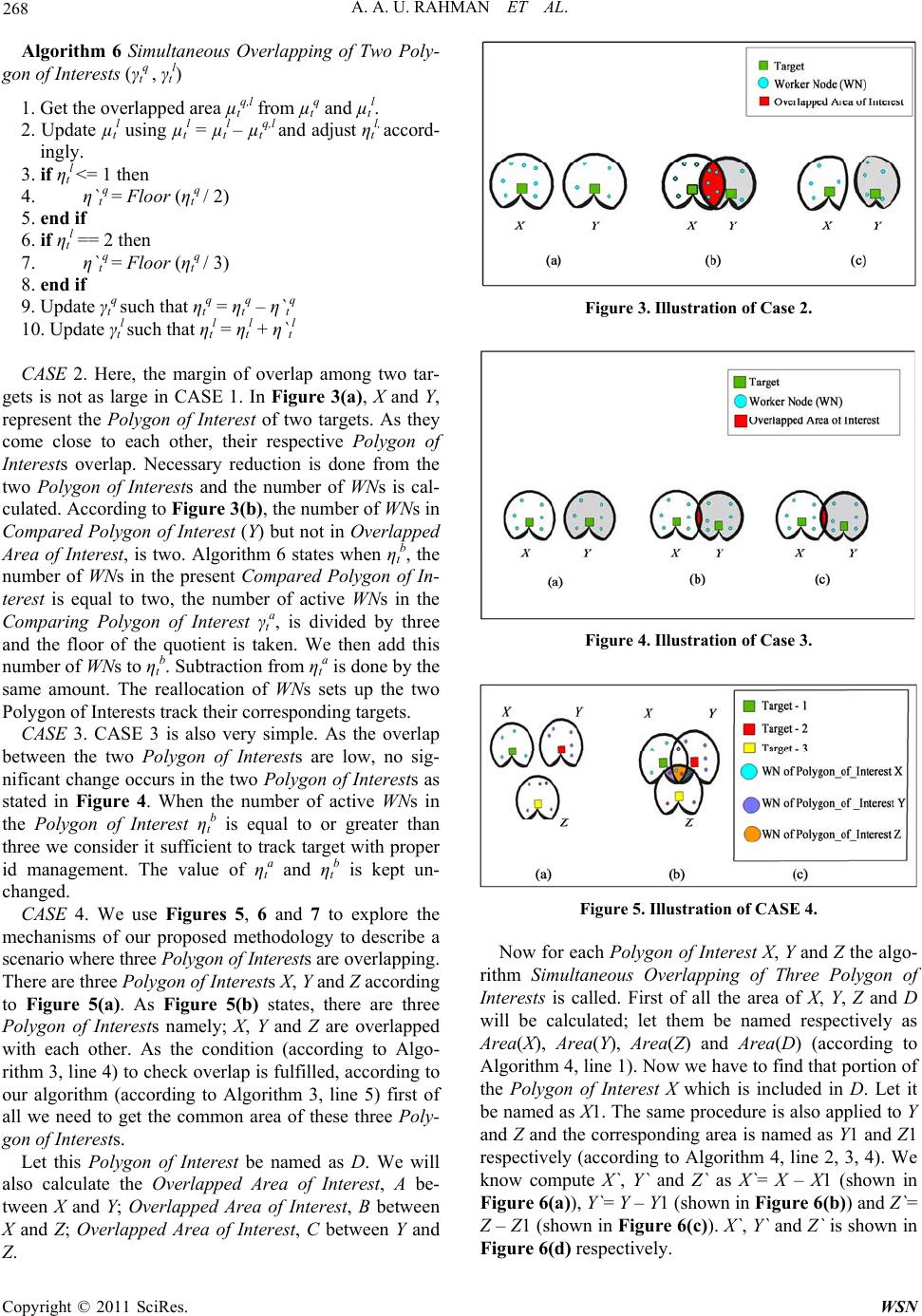 268 A. A. U. RAHMAN ET AL. Algorithm 6 Simultaneous Overlapping of Two Poly- gon of Interests (γt q , γt l) 1. Get the overlapped area µt q,l from µt q and µt l. 2. Update µt l using µt l = µt l – µt q,l and adjust ηt l, accord- ingly. 3. if ηt l <= 1 then 4. η`t q = Floor (ηt q / 2) 5. end if 6. if ηt l == 2 then 7. η`t q = Floor (ηt q / 3) 8. end if 9. Update γt q such that ηt q = ηt q – η`t q 10. Update γt l such that ηt l = ηt l + η`t l CASE 2. Here, the margin of overlap among two tar- gets is not as large in CASE 1. In Figure 3(a), X and Y, represent the Polygon of Interest of two targets. As they come close to each other, their respective Polygon of Interests overlap. Necessary reduction is done from the two Polygon of Interests and the number of WNs is cal- culated. According to Figure 3(b), the number of WNs in Compared Polygon of Interest (Y) but not in Overlapped Area of Interest, is two. Algorithm 6 states when ηt b, the number of WNs in the present Compared Polygon of In- terest is equal to two, the number of active WNs in the Comparing Polygon of Interest γt a, is divided by three and the floor of the quotient is taken. We then add this number of WNs to ηt b. Subtraction from ηt a is done by the same amount. The reallocation of WNs sets up the two Polygon of Interests track their corresponding targets. CASE 3. CASE 3 is also very simple. As the overlap between the two Polygon of Interests are low, no sig- nificant change occurs in the two Polygon of Interests as stated in Figure 4. When the number of active WNs in the Polygon of Interest ηt b is equal to or greater than three we consider it sufficient to track target with proper id management. The value of ηt a and ηt b is kept un- changed. CASE 4. We use Figures 5, 6 and 7 to explore the mechanisms of our proposed methodology to describe a scenario where three Polygon of Interests are overlapping. There are three Polygon of Interests X, Y and Z according to Figure 5(a). As Figure 5(b) states, there are three Polygon of Interests namely; X, Y and Z are overlapped with each other. As the condition (according to Algo- rithm 3, line 4) to check overlap is fulfilled, according to our algorithm (according to Algorithm 3, line 5) first of all we need to get the common area of these three Poly- gon of Interests. Let this Polygon of Interest be named as D. We will also calculate the Overlapped Area of Interest, A be- tween X and Y; Overlapped Area of Interest, B between X and Z; Overlapped Area of Interest, C between Y and Z. Figure 3. Illustration of Case 2. Figure 4. Illustration of Case 3. Figure 5. Illustration of CASE 4. Now for each Polygon of Interest X, Y and Z the algo- rithm Simultaneous Overlapping of Three Polygon of Interests is called. First of all the area of X, Y, Z and D will be calculated; let them be named respectively as Area(X), Area(Y), Area(Z) and Area(D) (according to Algorithm 4, line 1). Now we have to find that portion of the Polygon of Interest X which is included in D. Let it be named as X1. The same procedure is also applied to Y and Z and the corresponding area is named as Y1 and Z1 respectively (according to Algorithm 4, line 2, 3, 4). We know compute X`, Y` and Z` as X`= X – X1 (shown in Figure 6(a)), Y`= Y – Y1 (shown in Figure 6(b)) and Z`= Z – Z1 (shown in Figure 6(c)). X`, Y` and Z` is shown in Figure 6(d) respectively. Copyright © 2011 SciRes. WSN 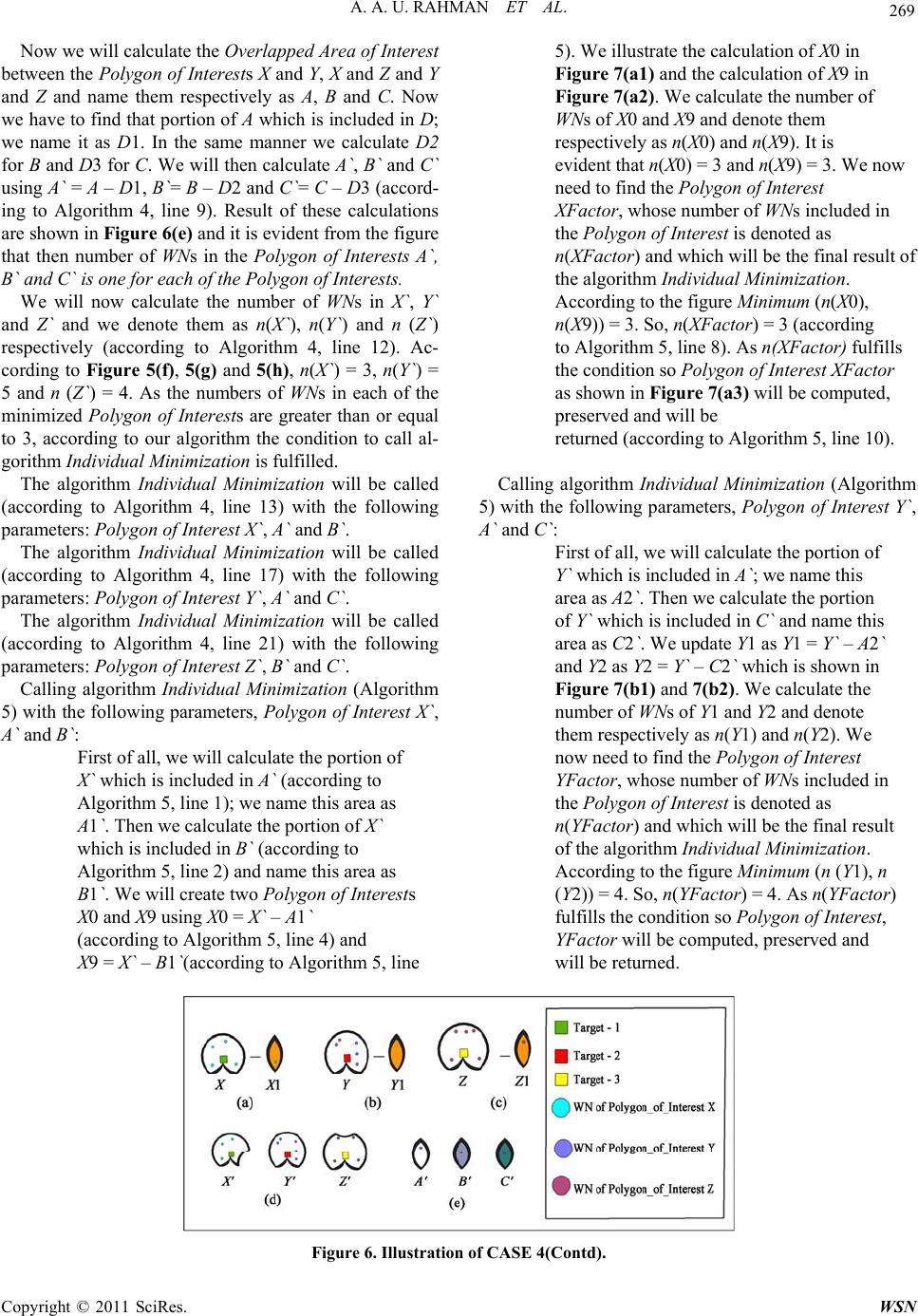 A. A. U. RAHMAN ET AL. Copyright © 2011 SciRes. WSN 269 5). We illustrate the calculation of X0 in Now we will calculate the Overlapped Area of Interest between the Polygon of Interests X and Y, X and Z and Y and Z and name them respectively as A, B and C. Now we have to find that portion of A which is included in D; we name it as D1. In the same manner we calculate D2 for B and D3 for C. We will then calculate A`, B` and C` using A` = A – D1, B` = B – D2 and C`= C – D3 (accord- ing to Algorithm 4, line 9). Result of these calculations are shown in Figure 6(e) and it is evident from the figure that then number of WNs in the Polygon of Interests A`, B` and C` is one for each of the Polygon of Interests. Figure 7(a1) and the calculation of X9 in Figure 7(a2). We calculate the number of WNs of X0 and X9 and denote them respectively as n(X0) and n(X9). It is evident that n(X0) = 3 and n(X9) = 3. We now need to find the Polygon of Interest XFactor, whose number of WNs included in the Polygon of Interest is denoted as n(XFacto r) and which will be the final result of the algorithm Individual Minimization. According to the figure Minimum (n(X0), We will now calculate the number of WNs in X`, Y` and Z` and we denote them as n(X`), n(Y`) and n (Z` ) respectively (according to Algorithm 4, line 12). Ac- cording to Figure 5(f), 5(g) and 5(h), n(X`) = 3, n(Y`) = 5 and n (Z`) = 4. As the numbers of WNs in each of the minimized Polygon of Interests are greater than or equal to 3, according to our algorithm the condition to call al- gorithm Individual Minimization is fulfilled. n(X9)) = 3. So, n(XFactor) = 3 (according to Algorithm 5, line 8). As n(XFactor) fulfills the condition so Polygon of Interest XFactor as shown in Figure 7(a3) will be computed, preserved and will be returned (according to Algorithm 5, line 10). The algorithm Individual Minimization will be called (according to Algorithm 4, line 13) with the following parameters: Polygon of Interest X`, A` and B`. Calling algorithm Individual Minimization (Algorithm 5) with the following parameters, Polygon of Interest Y`, A` and C`: The algorithm Individual Minimization will be called (according to Algorithm 4, line 17) with the following parameters: Polygon of Interest Y`, A` and C`. First of all, we will calculate the portion of Y` which is included in A`; we name this area as A2`. Then we calculate the portion The algorithm Individual Minimization will be called (according to Algorithm 4, line 21) with the following parameters: Polygon of Interest Z`, B` and C`. of Y` which is included in C` and name this area as C2`. We update Y1 as Y1 = Y` – A2` and Y2 as Y2 = Y` – C2` which is shown in Figure 7(b1) and 7(b2). We calculate the Calling algorithm Individual Minimization (Algorithm 5) with the following parameters, Polygon of Interest X` , A` and B`: number of WNs of Y1 and Y2 and denote them respectively as n(Y1) and n(Y2). We now need to find the Polygon of Interest First of all, we will calculate the portion of X` which is included in A` (according to YFa ctor, whose number of WNs included in the Polygon of Interest is denoted as Algorithm 5, line 1); we name this area as A1`. Then we calculate the portion of X` n(YFactor) and which will be the final result which is included in B` (according to of the algorithm Individual Minimization. According to the figure Minimum (n (Y1), n Algorithm 5, line 2) and name this area as B1`. We will create two Polygon of Interests (Y2)) = 4. So, n(YFactor) = 4. As n(YFacto r) fulfills the condition so Polygon of Interest, X0 and X9 using X0 = X` – A1` YFactor will be computed, preserved and (according to Algorithm 5, line 4) and X9 = X` – B1`(according to Algorithm 5, line will be returned. Figure 6. Illustration of CASE 4(Contd). 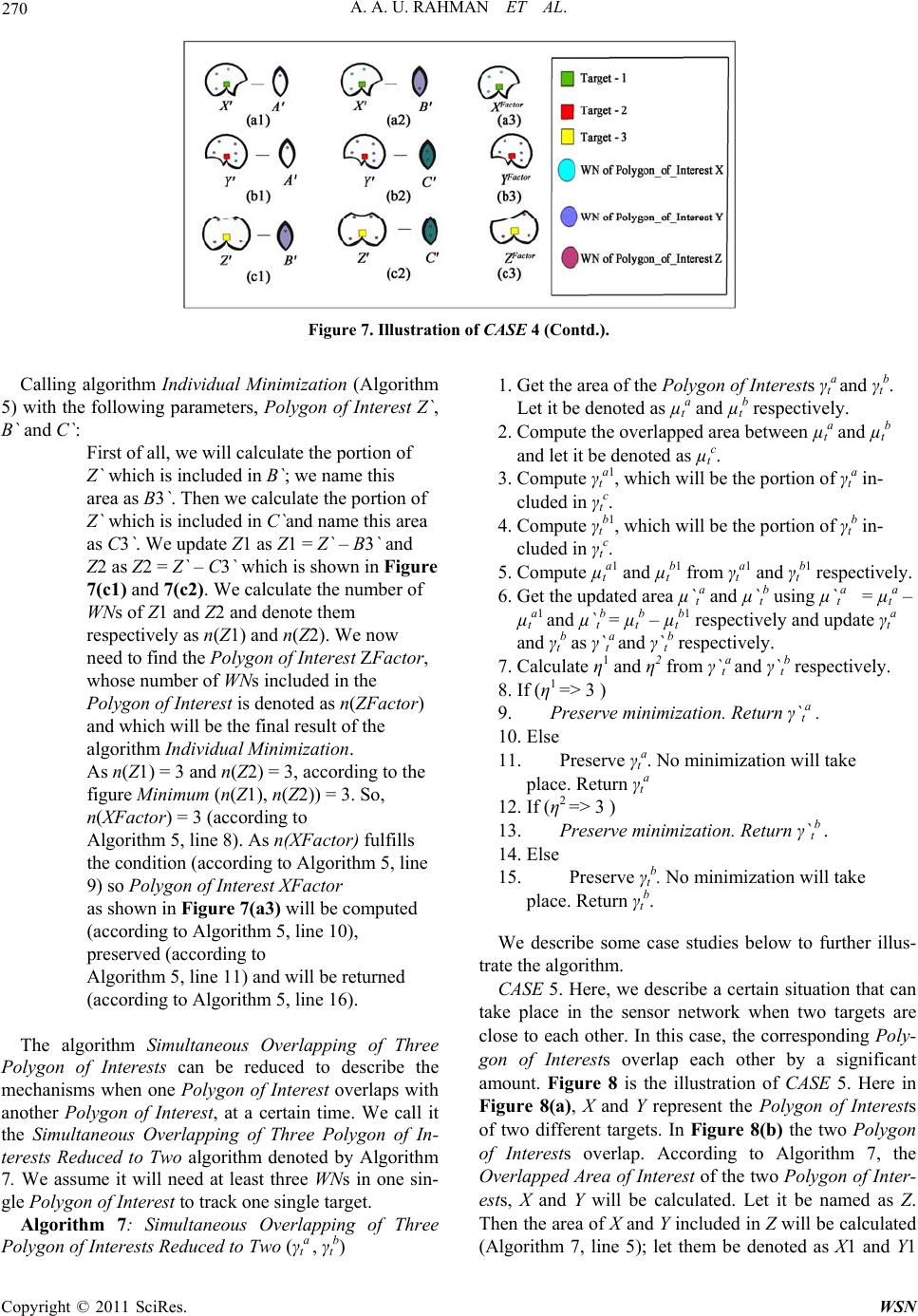 270 A. A. U. RAHMAN ET AL. Figure 7. Illustration of CASE 4 (Contd.). Calling algorithm Individual Minimization (Algorithm 5) with the following parameters, Polygon of Interest Z`, B` and C`: First of all, we will calculate the portion of Z` which is included in B` ; we name this area as B3`. Then we calculate the portion of Z` which is included in C`and name this area as C3`. We update Z1 as Z1 = Z` – B3` and Z2 as Z2 = Z` – C3` which is shown in Figure 7( c1) and 7(c2). We calculate the number of WNs of Z1 and Z2 and denote them respectively as n(Z1) and n(Z2). We now need to find the Polygon of Interest ZFactor, whose number of WNs included in the Polygon of Interest is denoted as n(ZFactor) and which will be the final result of the algorithm Individual Minimization. As n(Z1) = 3 and n(Z2) = 3, according to the figure Minimum (n(Z1), n(Z2)) = 3. So, n(XFactor) = 3 (according to Algorithm 5, line 8). As n(XFactor) fulfills the condition (according to Algorithm 5, line 9) so Polygon of Interest XFactor as shown in Figure 7(a3) will be computed (according to Algorithm 5, line 10), preserved (according to Algorithm 5, line 11) and will be returned (according to Algorithm 5, line 16). The algorithm Simultaneous Overlapping of Three Polygon of Interests can be reduced to describe the mechanisms when one Polygon of Interest overlaps with another Polygon of Interest, at a certain time. We call it the Simultaneous Overlapping of Three Polygon of In- terests Reduced to Two algorithm denoted by Algorithm 7. We assume it will need at least three WNs in one sin- gle Polygon of Interest to track one single target. Algorithm 7: Simultaneous Overlapping of Three Polygon of Interests Reduced to Two (γt a , γt b) 1. Get the area of the Polygon of Interests γt a and γt b. Let it be denoted as µt a and µt b respectively. 2. Compute the overlapped area between µt a and µt b and let it be denoted as µt c. 3. Compute γt a1, which will be the portion of γt a in- cluded in γt c. 4. Compute γt b1, which will be the portion of γt b in- cluded in γt c. 5. Compute µt a1 and µt b1 from γt a1 and γt b1 respectively. 6. Get the updated area µ`t a and µ`t b using µ`t a = µt a – µt a1 and µ`t b = µt b – µt b1 respectively and update γt a and γt b as γ`t a and γ`t b respectively. 7. Calculate η1 and η2 from γ`t a and γ`t b respectively. 8. If (η1 => 3 ) 9. Preserve minimization. Return γ`t a . 10. Else 11. Preserve γt a. No minimization will take place. Return γt a 12. If (η2 => 3 ) 13. Preserve minimization. Return γ`t b . 14. Else 15. Preserve γt b. No minimization will take place. Return γt b. We describe some case studies below to further illus- trate the algorithm. CASE 5. Here, we describe a certain situation that can take place in the sensor network when two targets are close to each other. In this case, the corresponding Poly- gon of Interests overlap each other by a significant amount. Figure 8 is the illustration of CASE 5. Here in Figure 8(a), X and Y represent the Polygon of Interests of two different targets. In Figure 8(b) the two Polygon of Interests overlap. According to Algorithm 7, the Overlapped Area of Interest of the two Polygon of Inter- ests, X and Y will be calculated. Let it be named as Z. Then the area of X and Y included in Z will be calculated (Algorithm 7, line 5); let them be denoted as X1 and Y1 Copyright © 2011 SciRes. WSN 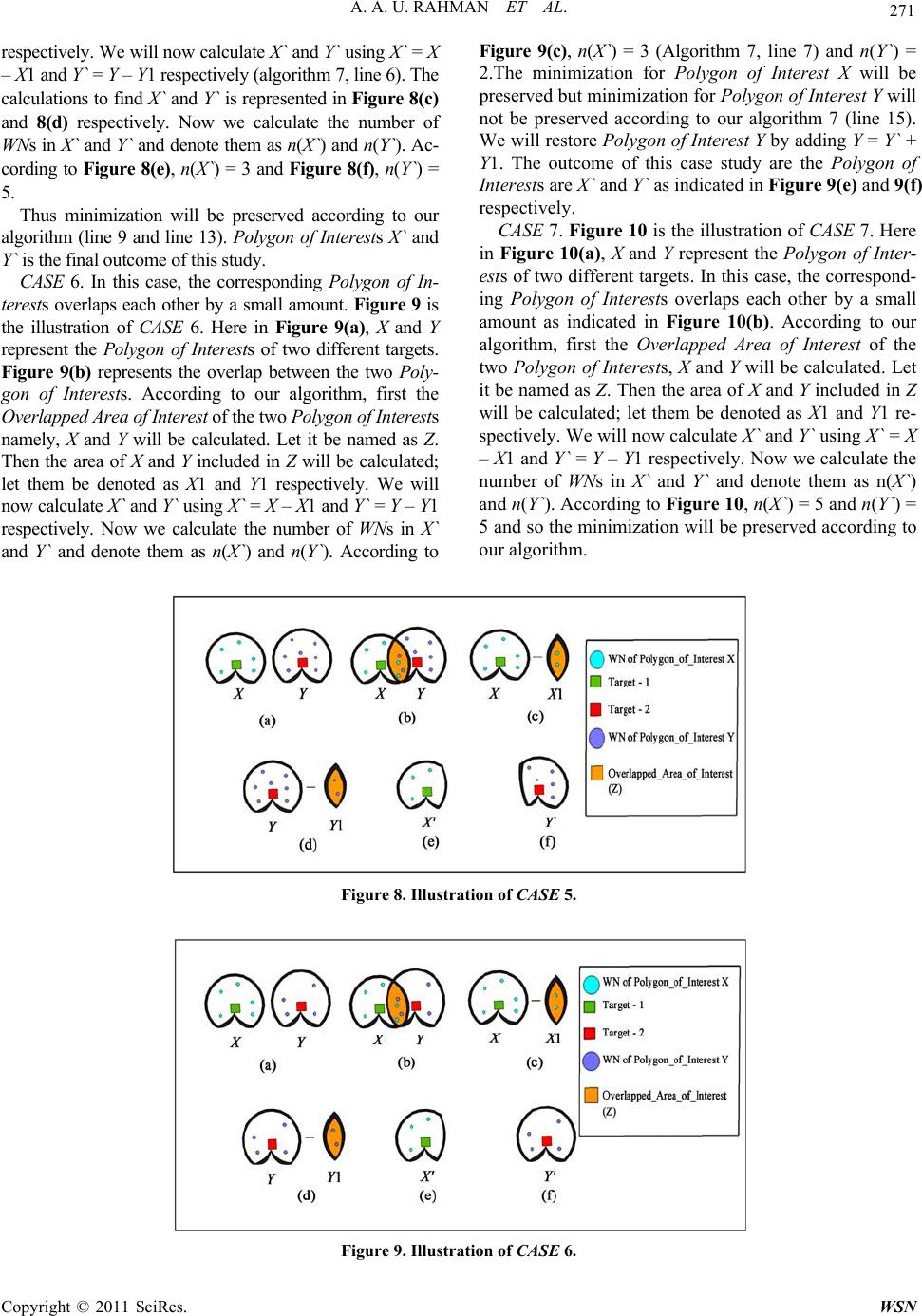 A. A. U. RAHMAN ET AL. 271 respectively. We will now calculate X` and Y` using X` = X – X1 and Y` = Y – Y1 respectively (algorithm 7, line 6). The calculations to find X` and Y` is represented in Figure 8(c) and 8(d) respectively. Now we calculate the number of WNs in X` and Y` and denote them as n(X`) and n(Y`). Ac- cording to Figure 8(e), n(X`) = 3 and Figure 8(f), n(Y`) = 5. Thus minimization will be preserved according to our algorithm (line 9 and line 13). Polygon of Interests X` and Y` is the final outcome of this study. CASE 6. In this case, the corresponding Polygon of In- terests overlaps each other by a small amount. Figure 9 is the illustration of CASE 6. Here in Figure 9(a), X and Y represent the Polygon of Interests of two different targets. Figure 9(b) represents the overlap between the two Poly- gon of Interests. According to our algorithm, first the Overlapped Area of Interest of the two Polygon of Interests namely, X and Y will be calculated. Let it be named as Z. Then the area of X and Y included in Z will be calculated; let them be denoted as X1 and Y1 respectively. We will now calculate X` and Y` using X` = X – X1 and Y` = Y – Y1 respectively. Now we calculate the number of WNs in X` and Y` and denote them as n(X`) and n(Y`). According to Figure 9(c), n(X`) = 3 (Algorithm 7, line 7) and n(Y`) = 2.The minimization for Polygon of Interest X will be preserved but minimization for Polygon of Interest Y will not be preserved according to our algorithm 7 (line 15). We will restore Polygon of Interest Y by adding Y = Y` + Y1. The outcome of this case study are the Polygon of Interests are X` and Y` as indicated in Figure 9(e) and 9(f) respectively. CASE 7. Figure 10 is the illustration of CASE 7. Here in Figure 10(a), X and Y represent the Polygon of Inter- ests of two different targets. In this case, the correspond- ing Polygon of Interests overlaps each other by a small amount as indicated in Figure 10(b). According to our algorithm, first the Overlapped Area of Interest of the two Polygon of Interests, X and Y will be calculated. Let it be named as Z. Then the area of X and Y included in Z will be calculated; let them be denoted as X1 and Y1 re- spectively. We will now calculate X` and Y` using X` = X – X1 and Y` = Y – Y1 respectively. Now we calculate the number of WNs in X` and Y` and denote them as n(X`) and n(Y`). According to Figure 10, n(X`) = 5 and n(Y`) = 5 and so the minimization will be preserved according to our algorithm. Figure 8. Illustration of CASE 5. Figure 9. Illustration of CASE 6. Copyright © 2011 SciRes. WSN 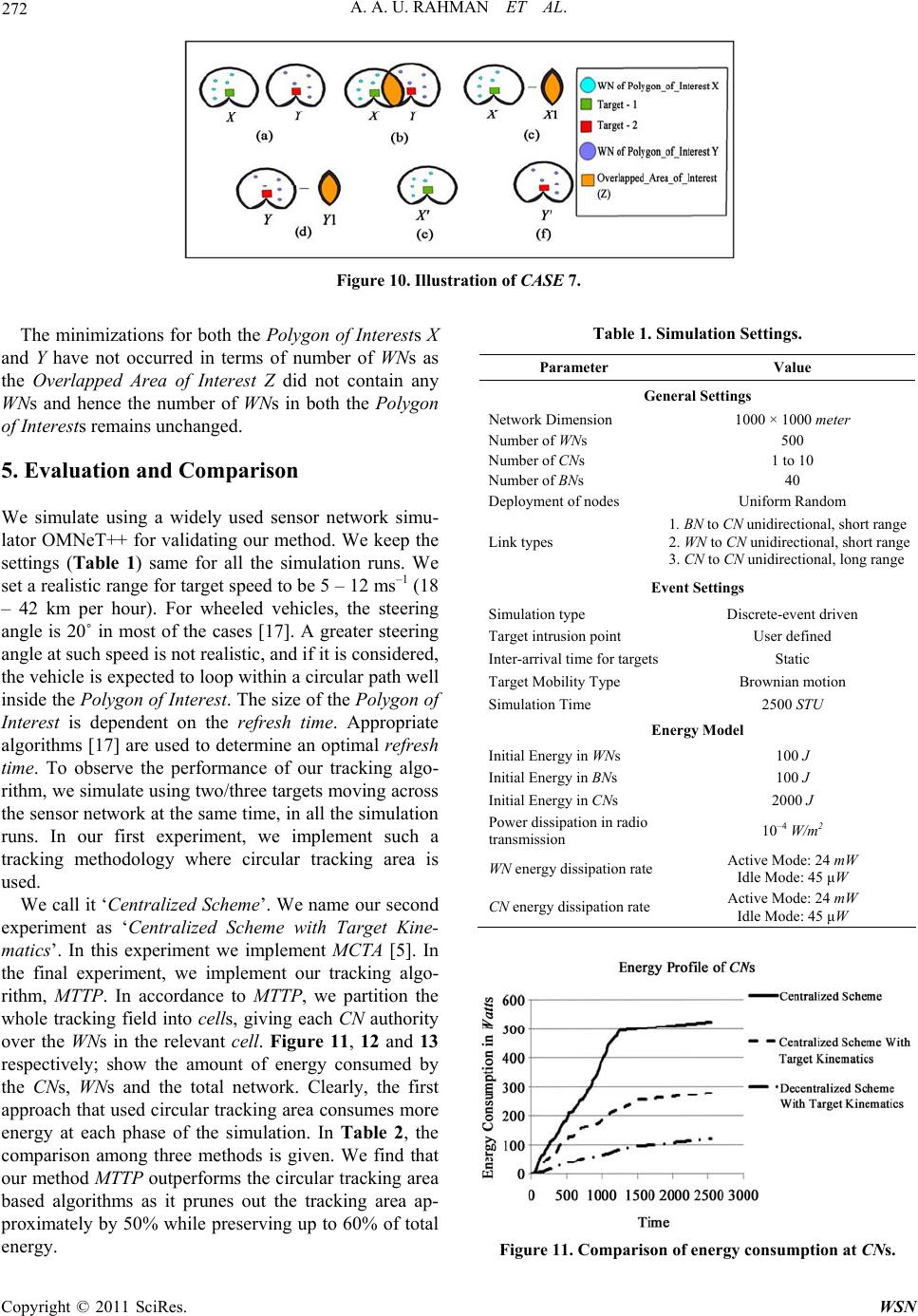 272 A. A. U. RAHMAN ET AL. Figure 10. Illustration of CASE 7. The minimizations for both the Polygon of Interests X and Y have not occurred in terms of number of WNs as the Overlapped Area of Interest Z did not contain any WNs and hence the number of WNs in both the Polygon of Interests remains unchanged. 5. Evaluation and Comparison We simulate using a widely used sensor network simu- lator OMNeT++ for validating our method. We keep the settings (Table 1) same for all the simulation runs. We set a realistic range for target speed to be 5 – 12 ms–1 (18 – 42 km per hour). For wheeled vehicles, the steering angle is 20˚ in most of the cases [17]. A greater steering angle at such speed is not realistic, and if it is considered, the vehicle is expected to loop within a circular path well inside the Polygon of Interest. The size of the Polygon of Interest is dependent on the refresh time. Appropriate algorithms [17] are used to determine an optimal refresh time. To observe the performance of our tracking algo- rithm, we simulate using two/three targets moving across the sensor network at the same time, in all the simulation runs. In our first experiment, we implement such a tracking methodology where circular tracking area is used. We call it ‘Centralized Scheme’. We name our second experiment as ‘Centralized Scheme with Target Kine- matics’. In this experiment we implement MCTA [5]. In the final experiment, we implement our tracking algo- rithm, MTTP. In accordance to MTTP, we partition the whole tracking field into cells, giving each CN authority over the WNs in the relevant cell. Figure 11, 12 and 13 respectively; show the amount of energy consumed by the CNs, WNs and the total network. Clearly, the first approach that used circular tracking area consumes more energy at each phase of the simulation. In Table 2, the comparison among three methods is given. We find that our method MTTP outperforms the circular tracking area based algorithms as it prunes out the tracking area ap- proximately by 50% while preserving up to 60% of total energy. Table 1. Simulation Settings. Parameter Value General Settings Network Dimension 1000 × 1000 meter Number of WNs 500 Number of CNs 1 to 10 Number of BNs 40 Deployment of nodes Uniform Random Link types 1. BN to CN unidirectional, short range 2. WN to CN unidirectional, short range 3. CN to CN unidirectional, long range Event Settings Simulation type Discrete-event driven Target intrusion point User defined Inter-arrival time for targetsStatic Target Mobility Type Brownian motion Simulation Time 2500 STU Energy Model Initial Energy in WNs 100 J Initial Energy in BNs 100 J Initial Energy in CNs 2000 J Power dissipation in radio transmission 10–4 W/m2 WN energy dissipation rate Active Mode: 24 mW Idle Mode: 45 μW CN energy dissipation rate Active Mode: 24 mW Idle Mode: 45 μW Figure 11. Comparison of energy consumption at CNs. Copyright © 2011 SciRes. WSN  A. A. U. RAHMAN ET AL. 273 Figure 12. Comparison of energy consumption at WNs. Figure 13. Comparison of energy consumption in the total network. Table 2. Simulation results. Simulation Name Centralized Scheme Centralized Scheme with Target Kinematics Decentralized Scheme with Target Kinematics Tracking Method Centralized Centralized Distributed Tracking Area Circular Polygon of Interest Polygon of Interest Simulation Time 2500 STU 2500 STU 2500 STU Tracking Time 1525 STU 1525 STU 1525 STU Total Polygon of Interests formed 136 136 136 Polygon of Interests Overlapped 53 41 41 Average WNs per Polygon of Interest 19.6 10.38 10.38 Maximum WNs per Polygon of Interest 33 21 21 Total dissipated energy in WNs 1646.5 J 795.5 J 640.2 J Total dissipated energy in CNs 523.2 J 276.6 J 121.3 J Total dissipated energy 2170.7 J 1072.2 J 761.5 J Number of transmission packets used 4703 2165 2681 Average transmission range 284.52 m 280.02 m 120.79 m Maximum transmission range 670.43 m 696.50 m 429.21 m 6. Conclusions In our paper, we propose a distributed energy efficient tracking method for tracking multiple targets in a large scale sensor network. We simulate our algorithm with a sensor network simulator and compare with other popu- lar methods. We find our method significantly saves sensor nodes’ energy. In future, we want to implement our algorithm in a real life scenario. We would like to explore multiple layers deployment of boundary sensors nodes which will increase good tracking service but will increase network cost. This trade-off is still an open re- search problem. 7. References [1] C. Sharp, S. Schaffet, A. Woo, N. Sastri, C. Karlof, S. Sastry and D. Culler, “Design and Implementation of a Sensor Network and Autonomous Interception,” Pro- ceedings of the 2nd European Workshop on Wireless Sensor Networks, Berkeley, 2005. [2] G. W. Allen, K. Lorincz, M. Welsh, O. Marcillo, J. Johnson, M. Ruiz and J. Lees, “Deploying a Wireless Sensor Network on an Active Volcano,” IEEE Internet Computing, Vol. 10, No. 2, March-April 2006, pp. 18-25. doi:10.1109/MIC.2006.26 [3] E. Yoneki and J. Bacon, “A Survey of Wireless Sensor Network Technologies: Research Trends and Middle- ware’s Role,” Ph.D. Dissertation, University of Cam- bridge, Cambridge, 2005. [4] W. Zhang and G. Cao, “Dynamic Convoy Tree based Collaboration for Target Tracking in Sensor Networks,” IEEE Transactions on Wireless Communication, Vol. 3, No. 5, September 2004, pp. 1689-1701. doi:10.1109/TWC.2004.833443 [5] J. Jeong, T. Hwang, T. He and D. Du, “(MCTA) Target Tracking Algorithm based on Minimal Contour in Wire- less Sensor Networks,” Technical Report, University of Minnesota, Twin Cities, 2007. [6] S. M. LaValle, “Planning Algorithms,” Cambridge Uni- versity Press, Cambridge, 2006. Copyright © 2011 SciRes. WSN  274 A. A. U. RAHMAN ET AL. [7] OMNeT++ Community Site. http://www.omnetpp.org [8] Y. Bar-Shalom and T. E. Fortmann, “Tracking and Data Association,” Academic Press Professional, San Diego, 1987. [9] H. Yang and B. Sikdar, “A Protocol for Tracking Mobile Targets Using Sensor Networks,” Proceedings of the IEEE Workshop on Sensor Network Protocols and Ap- plications, Vol. 7, 2003, pp. 71-81. doi:10.1109/SNPA.2003.1203358 [10] Tinynode. http://www.tinynode.com [11] W. AlSalih, K. Islam, Y. N. Rodriguez and H. Xiao, “Distributed Voronoi Diagram Computation in Wireless Sensor Networks,” Proceedings of the 20th ACM Sympo- sium on Parallelism in Algorithms and Architectures (SPAA), 2008, p. 364. doi:10.1145/1378533.1378597 [12] X. Du and F. Lin, “Maintaining Differentaited Coverage in Heterogenous Sensor Networks,” EURASIP Journal on Wireless Communication and Networking, Vol. 2005, No. 54, August 2002, pp. 459-461. doi:10.1155/WCN.2005.565 [13] Bob Stein, “A Point About Polygons,” Linux Journal, March 1997. [14] J. A. Stankovic, T. Abdelzaher, and T. He, “Lightweight Detection and Classification for Wireless Sensor Net- works in Realistic Environments,” Proceedings of the 3rd ACM Conference on Embedded Networked Sensor Sys- tems, San Diego, November 02 - 04 2005, pp. 205-217. doi:10.1145/1098918.1098941 [15] R. R. Brooks, P. Ramanathan and A. M. Sayeed, “Dis- tributed Target Classification and Tracking in Sensor Networks,” Proceedings of the IEEE, Vol. 31, No. 8, 2003, pp. 1163-1171. doi:10.1109/JPROC.2003.814923 [16] A. U. R. Akond, M. A. I. Mollah and M. Naznin, “Multi- ple Targets Tracking in Wireless Sensor Networks using Target Kinematics,” Undergraduate Thesis, Bangladesh University of Engineering and Technology, Dhaka, 2009. [17] D. R. Kincaid and W. W. Cheney, “Numerical Analysis the Mathematics of Scientific Computing,” American Mathematical Society, Rhode Island, 2002. Copyright © 2011 SciRes. WSN
|